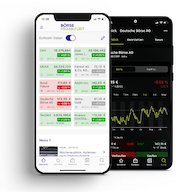Market sentiment: “The new carefree attitude”

Many bears are taking profits and switching directly to the long side. Joachim Goldberg knows whether this already counts as a contraindication.
Summary
Despite considerable risks such as the Middle East and tariff conflicts, investors remain largely unimpressed and are buying stocks across the board, with 23 percent of professionals and 10 percent of private investors closing their short positions. Almost all professionals and all private investors have entered the stock market, with sentiment indices shooting up to +45 and +20 points. For Joachim Goldberg, this is a very remarkable change in sentiment, which is likely to have been facilitated by significant gains.
The behavioral economist does not yet see any dangerous euphoria, but expects profit-taking from 24,050/24,100 points onwards – and warns against excessive complacency.
25 June 2025. FRANKFURT (Goldberg & Goldberg). Many financial market participants are likely to have wondered how long the latest ceasefire between Israel and Iran would last. Of course, the reaction of the stock markets on both sides of the Atlantic was also an expression of hope that the term chosen by US President Donald Trump - a twelve-day war - would prove to be accurate. The DAX also recovered impressively from its low since the last sentiment survey and even posted a small gain of 0.6% on the week.
However, in view of the armed conflicts and the temporary threat of a dramatic escalation, another war is likely to have taken a back seat. We are talking about the trade war that Donald Trump started at the beginning of April on Liberation Day and whose pause imposed shortly afterwards is now set to end on 8 July. At least for the time being. For the international fund managers interviewed in the Bank of America survey, this trade war was still the biggest event risk last week, combined with the fear that it could trigger a global recession. However, as an observer, one certainly gets the impression that many players have already become accustomed to the threat of tariffs or are even expecting another extension of the “tariff pause”. But the deadline for the so-called “One Big Beautiful Bill” is also approaching. The new US budget law under this name is due to be passed on 4 July.
Sharp change in mood
Meanwhile, the institutional investors we surveyed with a medium-term trading horizon have undergone a seemingly dramatic change in sentiment. Our Börse Frankfurt Sentiment Index has risen by an almost unbelievable 45 points to a new level of +20. Many pessimists, who remained hesitant in the previous week despite some significant gains, have now taken them with them. But that's not all: on balance, almost all former bears have gone straight to the bulls, i.e. turned their positions around 180°. This change in sentiment affects 22% of all respondents. At the same time, the sentiment index is at its second-highest level this year.
There has been a very similar development among private investors. The Börse Frankfurt Sentiment Index in this panel rose from zero to +20. The change in sentiment was not quite as great here, but the bottom line is that 10% of respondents switched directly from the bear camp to the bull camp, i.e. they started new investments with profits behind them. This time, we find this development equally among the investors we surveyed via social media as well as among the other panel participants. The gap between these two subgroups has therefore hardly changed.
Well bedded on profit cushions
According to today's survey, there is no sentiment gap between private investors and institutional investors. However, we do find a larger proportion of neutral investors among the latter.
In addition, three things can be noted. On the one hand, many investors are likely to have found it easy to switch to the bull side in view of the frequent profit cushions. On the other hand, the almost euphoric change in sentiment is quite remarkable, although the new optimism is not yet dangerously pronounced - we are a long way from that. However, profit-taking - probably more pronounced for the first time in the 24,050/24,100 points range - is likely to hinder further DAX gains, at least temporarily. Thirdly, it can be stated that a large part of the upward momentum is home-made, i.e. probably not the result of major international capital flows.
Even if the positioning is not extremely bullish, many investors appear to have become somewhat carefree due to the aforementioned profit cushion. At the very least, downside protection is probably too low in view of the aforementioned event risks.
by Joachim Goldberg
25 June 2025, © Goldberg & Goldberg for boerse-frankfurt.de
Video commentary (German)
Sentiment index of institutional investors

| Bullish | Bearish | Neutral | |
| Total | 47% | 27% | 26% |
| vs. last survey | +22% | -23% | +1% |
DAX (change compared to previous survey): 23,620 points (+130 points compared to the last survey)
Börse Frankfurt Sentiment Index institutional investors: +20 points (+45 points compared to the last survey)
Sentiment index of private investors

| Bullish | Bearish | Neutral | |
| Total | 51% | 31% | 18% |
| vs. last survey | +10% | -10% | +0% |
DAX (change compared to previous survey): 23,620 points (+130 points compared to last survey)
Börse Frankfurt Sentiment Index Private Investors: +20 points (+20% compared to last survey)
About the Börse Frankfurt Sentiment Index
The Börse Frankfurt Sentiment Index ranges between -100 (total pessimism) and +100 (total optimism), with the transition from positive to negative values marking the neutral line.
More articles from this columnist
| Time | Title |
|---|






